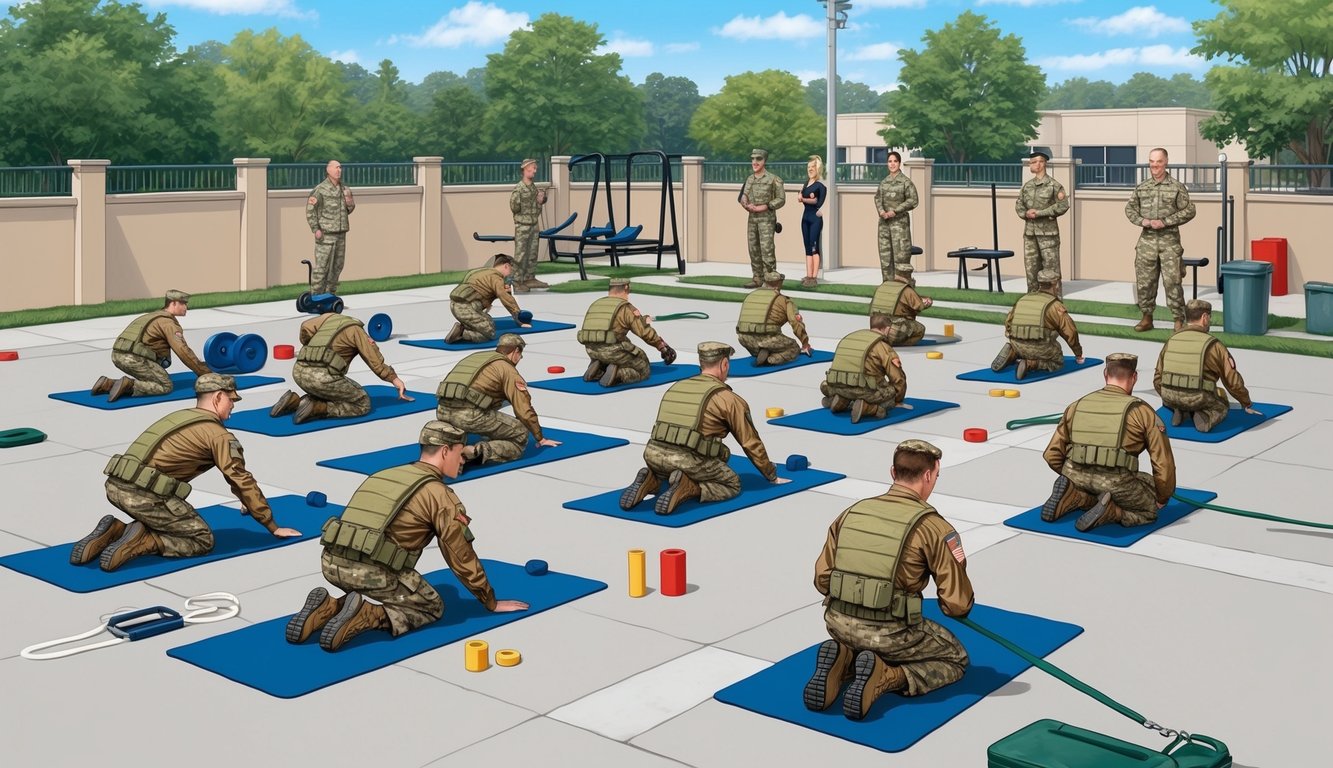The Army tape test is an essential component of the military’s standards for fitness and body composition.
Its purpose is to ensure soldiers maintain a healthy weight and fulfill physical fitness requirements.
During the test, specific body metrics are measured using a tape measure to determine body fat percentage.
Soldiers are required to stay within defined limits based on their age and gender.
For soldiers and prospective recruits, grasping these standards is vital for both career trajectory and personal health.
The Army frequently revises its policies to incorporate the latest scientific findings and enhance performance.
Recent updates have led to the implementation of a new circumference-based tape test methodology, aimed at delivering more precise evaluations of body composition.
Adhering to the Army’s tape standards goes beyond merely fulfilling requirements; it’s about ensuring your readiness and efficiency as a soldier.
Consistent evaluations, combined with a comprehensive approach to health and fitness, enable you to maintain peak condition for the challenges of military service.
Key Takeaways
- The Army tape standards evaluate body fat percentage through specific measurements and calculations.
- Regular assessments of body composition are carried out to confirm that soldiers meet fitness standards.
- Achieving tape standards is vital for maintaining military readiness and for career advancement.
Understanding Army Tape Standards

The Army tape test serves as an important method to evaluate the body composition and fitness levels of soldiers.
It entails taking specific measurements and applying calculations to determine if personnel meet established standards.
Basics of the Tape Test
The Army tape test assesses body circumference to estimate body fat percentage.
Male service members typically have their neck and waist measured, while female service members have their neck, waist, and hip measurements taken.
These measurements are obtained using a standard cloth measuring tape.
For males, body fat is determined by subtracting the neck measurement from the waist measurement.
For females, the waist and hip measurements are summed, and the neck measurement is subtracted.
These figures are then used along with height to provide an estimated body fat percentage.
As of 2024, the Army has introduced a new one-site tape test method, which evaluates only the abdomen for a faster and more consistent assessment.
The Role of Body Composition
Your body composition is crucial to your overall health and military readiness.
The Army has set specific standards to guarantee soldiers maintain a fitness level that supports their responsibilities and longevity in their roles.
Meeting these criteria is not solely about appearance; it is inherently linked to being prepared for the physical demands of your position.
Excess body fat can negatively affect performance, endurance, and long-term health.
Failure to meet the standards may lead to enrollment in the Army Body Composition Program, which offers guidance and support to help you achieve and sustain a proper body composition through effective nutrition and exercise.
Policy and Regulations

The U.S. Army has established clear guidelines for body composition and fitness standards.
These regulations are designed to ensure soldiers maintain combat readiness as well as overall health.
Army Regulation 600-9
AR 600-9 outlines the Army Body Composition Program (ABCP).
This regulation specifies the acceptable body fat percentages correlated with age and gender.
Additionally, it describes the procedures for measuring body fat using the tape method.
Soldiers who exceed the maximum allowable body fat percentage may face administrative actions, such as mandatory enrollment in a weight control program or even separation from the service.
AR 600-9 underscores the necessity of regular weigh-ins and body fat assessments, placing the responsibility on unit commanders to ensure their soldiers comply with these standards.
Recent Directives and Policy Changes
Army Directive 2023-11 has rolled out significant changes regarding body fat assessment methods.
Effective June 9, 2024, the one-site (abdomen) circumference-based tape method has become the primary authorized measurement technique.
A supplemental body fat assessment is now accessible for soldiers who do not pass the initial tape test, enabling a more thorough evaluation of body composition.
Furthermore, Army Directive 2023-08 has connected the ABCP to Army Combat Fitness Test scores, granting exceptions to body fat standards for soldiers who perform well in the ACFT, thus recognizing overall fitness beyond just body composition.
These adjustments illustrate the Army’s ongoing initiative to refine its fitness policies and ensure that they effectively assess combat readiness.
Eligibility and Requirements

To meet Army tape test standards, specific height, weight, and body fat criteria must be satisfied.
These standards differ based on age and gender to promote appropriate fitness levels among soldiers.
Height and Weight Standards
Your height and weight are considered first.
The Army utilizes a chart correlating acceptable weight ranges with different heights.
For instance, a male soldier who stands 68 inches tall has a maximum allowable weight of 180 pounds.
If you exceed the weight limit for your height, a body fat assessment will be required, where the tape test comes into play.
Body Fat Standards for Different Age Groups
Body fat standards become more flexible as soldiers age.
For male soldiers aged 17-20, the maximum allowable body fat is 20%.
This threshold increases to 22% for ages 21-27, 24% for ages 28-39, and 26% for those aged 40 and above.
For female soldiers, the allowable body fat percentages are higher.
For ages 17-20, up to 30% is acceptable; 21-27 can have up to 32%; 28-39 can reach up to 34%; and for those 40 and older, up to 36% is permissible.
Keep in mind that these are the maximum limits, and it is advisable to stay well below these percentages for optimal fitness and performance in your Army duties.
Assessment Procedures
The Army employs specific methodologies to assess body composition and ensure soldiers meet fitness benchmarks.
These methods include the primary tape test as well as alternative assessment options for more accurate measurements.
Performing the Army Tape Test
To conduct the Army tape test, you’ll require a measuring tape and a partner.
The test centers around key body areas:
- Neck measurement: The tape is wrapped around the neck just beneath the larynx.
- Waist measurement: For males, this is measured at the navel, while for females, it is taken at the narrowest part of the waist.
- Hip measurement (females only): The widest part of the hips is measured.
Make sure to record measurements to the nearest half-inch.
The Army uses these figures in a formula to estimate your body fat percentage.
It is important to conduct the test in your physical training uniform for consistency.
Supplementary Assessment Options
If you are dissatisfied with your tape test results, several alternative methods are available:
- Bod Pod: This egg-shaped chamber measures body density through air displacement.
- DXA scan: Utilizes low-dose X-rays for detailed body composition analysis.
- InBody 770: A bioelectrical impedance device that estimates body fat percentage.
While these methods can yield more precise measurements, they may not be accessible at all locations, and you may need command approval to utilize them.
Remember, the standard tape test remains the primary assessment tool for most Army personnel.
Calculations and Tools

The Army provides specific tools and formulas to aid soldiers in accurately gauging their body fat percentages, ensuring consistent and reliable results across the military.
Using the Army Body Fat Calculator
You can conveniently determine your body fat percentage using the Army Body Fat Calculator.
This online resource simplifies the process by allowing you to enter your measurements and receive immediate results.
To use the calculator, you will need to provide your age, weight, and abdominal circumference for the new 2023 one-site test.
For the previous multi-site test, you will input your height, neck, waist, and hip measurements.
This user-friendly calculator offers quick feedback on whether you meet the Army’s body composition standards and serves as a helpful tool for both current soldiers and those preparing to enlist.
Understanding the Equations
For calculating body fat percentage based on tape test measurements, the Army employs specific equations.
For the new 2023 one-site test, the formula accounts for age, weight, and abdominal circumference, though the exact formula is not publicly disclosed.
It is crafted to deliver a more accurate body fat estimate compared to the prior method.
For the older multi-site test, distinct equations are applied for men and women:
Men: % Body Fat = 86.010 x log10(waist – neck) – 70.041 x log10(height) + 36.76
Women: % Body Fat = 163.205 x log10(waist + hip – neck) – 97.684 x log10(height) – 78.387
These equations standardize the process of calculating body fat throughout the Army.
Army’s Fitness Programs

The U.S. Army upholds stringent fitness standards to guarantee soldiers are combat-ready.
These programs assess both physical fitness and body composition, concentrating on strength, endurance, and overall wellness.
Army Body Composition Program (ABCP)
The ABCP ensures soldiers stay within a healthy weight range and body fat percentage.
As of October 2024, the program utilizes a one-site tape test method for body fat assessment, focusing solely on abdominal circumference for all soldiers.
Recent updates to the Army’s policies include:
- Soldiers scoring 540+ points on the ACFT (with 80+ in each event) are exempt from the tape test.
- A 12-month grace period is provided to continue using the previous multi-site tape test for confirmation purposes.
- From June 9, 2024, only the one-site method is authorized.
These modifications are aimed at offering a more accurate and equitable evaluation of soldiers’ body composition.
Army Combat Fitness Test (ACFT)
The ACFT stands as the Army’s all-encompassing physical fitness examination.
It comprises six events that challenge various aspects of fitness:
- 3-Repetition Maximum Deadlift
- Standing Power Throw
- Hand-Release Push-Ups
- Sprint-Drag-Carry
- Leg Tuck or Plank
- 2-Mile Run
Your performance on the ACFT is pivotal for your military career.
Scoring 540 or more points can grant you an exemption from the ABCP tape test.
The Army provides numerous resources, including the ACFT website, to assist you in training and enhancing your scores.
Support and Resources
The Army offers extensive support to help soldiers meet and maintain tape test standards.
Qualified professionals provide individualized guidance on nutrition, exercise, and overall well-being.
Health and Nutrition Guidance
You have access to registered dietitians who are prepared to create customized meal plans to aid you in achieving your fitness objectives.
These specialists can clarify how proper diet influences body fat levels and general health.
They will collaborate with you to cultivate sustainable eating habits that support your performance.
Your healthcare provider can supply insights into how your diet impacts weight and body composition, possibly recommending supplements or specific foods to enhance metabolism and promote muscle growth.
Fitness Training and Support
Master Fitness Trainers are in place to design workout routines suited to your requirements.
These experts will assist you in targeting specific areas and enhancing your overall physique.
You will receive guidance on effective exercise techniques to maximize results while minimizing the risk of injury.
Trainers can advise you on striking a balance between cardio and strength training for optimal body composition.
Additionally, joining group fitness classes or finding workout partners can promote motivation and accountability.
Consistency remains essential for achieving and maintaining your fitness aspirations.
Maintaining Standards and Readiness
The Army’s standards for physical fitness and body composition are integral to mission success and operational effectiveness.
These criteria help ensure soldiers are equipped to handle the physical demands of their roles.
Unit and Individual Readiness
Regular exercise complemented by a balanced diet will help you meet the Army's fitness criteria.
Aim for a minimum of 150 minutes of moderate aerobic activity or 75 minutes of vigorous activity each week.
Incorporating strength training is equally important.
Your physical capabilities directly influence your unit’s effectiveness, and by maintaining fitness, you contribute to overall mission readiness.
Keep in mind that fitness goes beyond simply passing assessments—it’s about being equipped for the challenges that military service entails.
Consequences for Non-Compliance
Failing to meet Army body composition standards can seriously affect your career progression.
You may be flagged, which can inhibit promotions, attendance at military schools, or eligibility for awards.
If you do not comply with the standards, you will be enrolled in the Army Body Composition Program, which entails regular weigh-ins and counseling.
You will be granted a set period to meet these requirements.
Persistent failure to comply could result in administrative actions, including separation from service.
It is important to take these standards seriously and to seek support if you are facing challenges in meeting them.
Conclusion
The Army’s tape test standards are continuously evolving.
Recent changes underscore the aim to provide more accurate evaluations of soldiers’ body compositions.
The introduction of the new one-site tape test streamlines the process while maintaining high fitness expectations.
Leaders within the Army understand the necessity for these adaptations, working to align combat readiness with realistic body composition targets.
The overall goal for the Department of Defense is to ensure a fit and capable fighting force.
These changes might directly impact your service experience.
Remember, the ACFT score exemption provides an alternate route for top performers, reflecting the Army’s commitment to recognizing overall fitness.
Stay up to date with these standards as they can continue to evolve.
Your physical readiness remains vital to your military career.
Continue focusing on your health and fitness to meet and surpass these requirements.
Frequently Asked Questions
Recent changes to the Army’s body composition standards and tape test procedures have occurred.
Below are answers to common questions about the current requirements and methodologies.
What are the latest modifications to the Army body fat tape test for 2024?
The Army has implemented a new one-site tape test in 2023.
This streamlined method measures only the waist circumference for male soldiers and the hip circumference for female soldiers.
The prior multi-site tape test may still be employed as a confirmation test for 12 months following the implementation of the new policy.
How do female soldiers fulfill the current Army tape standards?
Female soldiers must adhere to specific body fat percentage limits corresponding to their age groups.
The tape test for women assesses neck and hip circumferences.
To pass, women must attain at least 50 points in all three events of the Army Combat Fitness Test, which includes push-ups, sit-ups, and a two-mile run.
What method does the Army use to determine body fat percentage?
The Army utilizes circumference measurements to estimate body fat percentage.
For men, neck and waist measurements are taken, while women’s measurements include neck and hip values.
These measurements are then applied to gender-specific formulas to derive the estimated body fat percentage.
Can you explain the guidelines specified in AR 600-9 concerning the tape test?
AR 600-9 delineates the Army Body Composition Program and sets the maximum allowable body fat percentages based on age and gender.
The regulation also details proper tape measurement techniques and the frequency of assessments for soldiers surpassing weight standards.
Where can I access the updated Army height and weight calculator for 2024?
The official Army Body Fat Calculator is available on the U.S. Army website.
This tool allows you to input your measurements and calculates your estimated body fat percentage in accordance with the most current standards.
Do you have any advice for successfully meeting the Army’s body fat tape test?
To succeed in the tape test, focus on maintaining a healthy diet alongside a regular exercise routine, paying particular attention to core-strengthening workouts that can reduce waist circumference.
Additionally, ensure you are well-hydrated and avoid heavy meals or high-sodium foods before the test, as these factors can cause bloating and influence measurements.

